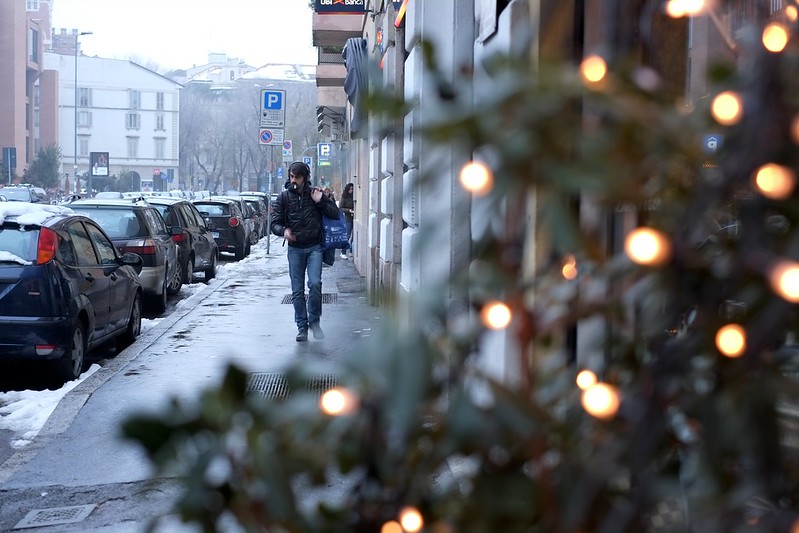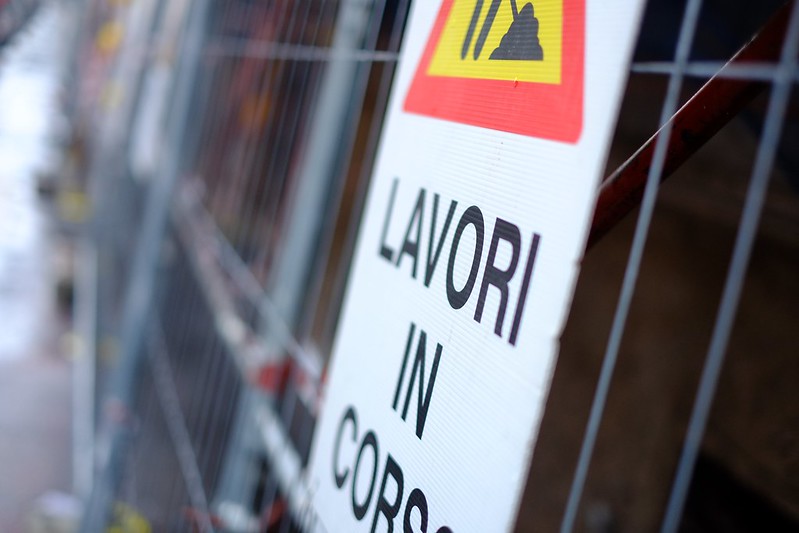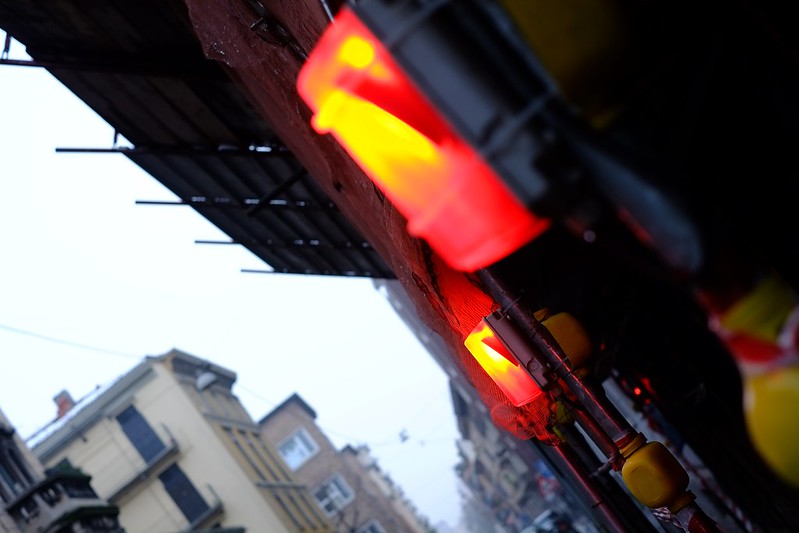Last Sunday Fuji organized a test event in Milano, so I grabbed the opportunity to play with the XE-1 for a good fifteen minutes.
The event was a crowd-pleaser; a perfectly lit1, beautiful model striking sexy-annoyed poses for all those who were interested in this type of photography (a good number, from what I could see). Two street/documentary photographers leading hour-long walks in the surroundings. The possibility to use any camera you wanted2, and play with it at will, in the gallery or outside on the streets.
 You should check how sharp the kid is at 100% (you pixel-peeper).
You should check how sharp the kid is at 100% (you pixel-peeper).
I had little time so no street tour for me; after a short wait playing with the X-103, I finally grabbed an XE-1 all pimped up the way I wanted — deep blacks and the 35mm f/1.4 put up front. It was a wonderful opportunity to see in person what’s all the fuss about these cameras. I just walked for a couple of blocks and snapped around 30 shots.
And what I have found is that this is indeed a great little camera, something that makes you play on the streets and have fun shooting, maybe because it is so much more subtle than a DSLR; I had the nerve to use the camera at unusual (for me) short ranges, and it felt better than holding some distance and getting “close” with a short tele for example.
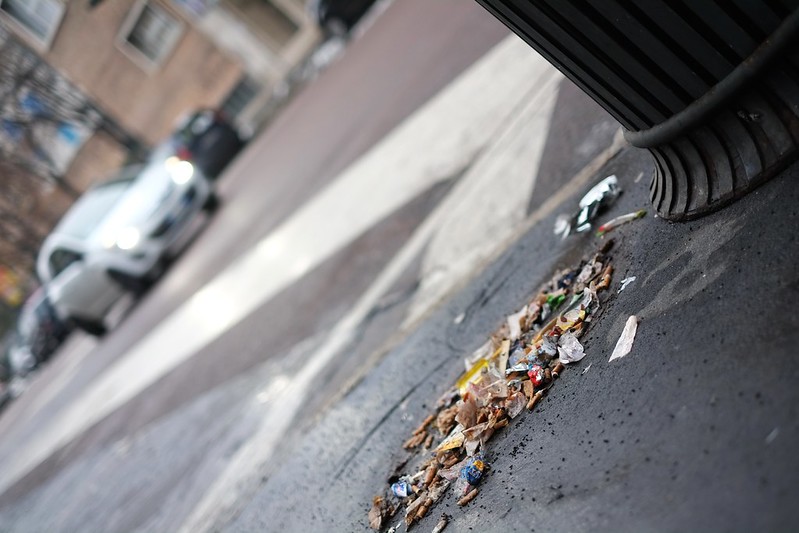 The required shot at f/1.4 just to show off some bokeh.
The required shot at f/1.4 just to show off some bokeh.
You see, I guess that the appeal of street photography is that it’s something that doesn’t require too much preparation and equipment; but then purists come up front and put some extra barriers, arguing for example that street photography has to be done with a normal or wide angle lens because Cartier-Bresson blah blah blah. Who cares, since I got the 85mm on my Nikon (which translates into a 135mm focal length, 35mm-wise) I appreciate the extra reach. And the Nikkor 85mm is pretty small, but there was this time when I was taking casual shots with a friend of mine, and he had this big 180mm f/2.8 on his D700; and walking with a DSLR and a big lens makes me feel probably even more uncomfortable than getting close to the subjects, because it feels like if I was some sort of stalker.
So excuse me for the long detour, but this is just to say how good it feels to use this camera, for it’s a frugal and understated piece of metal, it does not shout ‘paparazzo’ nor it threatens people, and I feel like I could do some real street photos (the wide-angle lens, right-in-the-middle-of-the-action stuff). So you see, despite what true artists say, it is the GEAR after all that makes you want to go out and create.
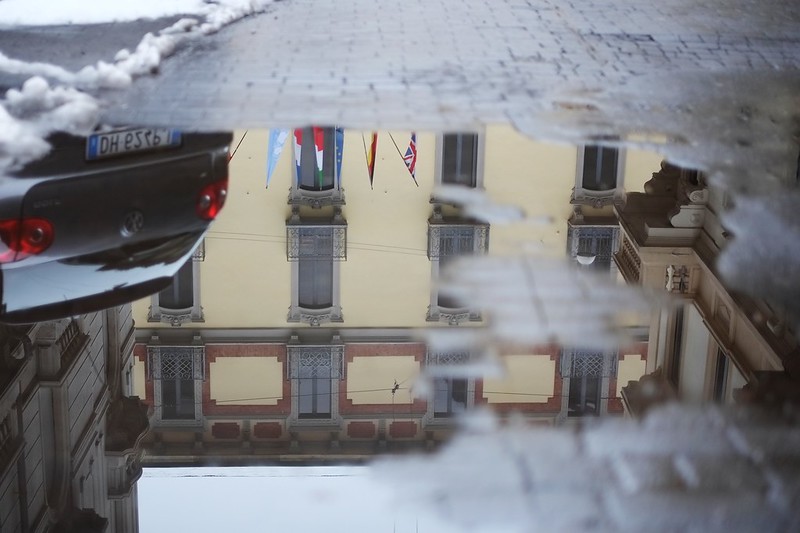 Slightly cropped and minor contrast boost, this is the shot that required the most post-processing. Total time spent on the computer for this: around 45 seconds.
Slightly cropped and minor contrast boost, this is the shot that required the most post-processing. Total time spent on the computer for this: around 45 seconds.
Everything you have read on the internet is really true; good mechanical feelings from the body but even more so from the wonderful lens; wonderful for how it’s built, all solid, black metal, with a lovely focus ring and some neat FUJI XF F/1.4 signs on the border of the glass that speaks like if it’s a german no-frills piece of machinery. Wonderful for its character which goes beyond resolution and chromatic aberration and other dpreview onanistic parameters; I approached this test with no really big hopes about getting good images so when I watched the jpegs back home I was really surprised to see tack sharp shots out of an unstable pose, one or two good panning, nice colors out of the box. The fact that I was able to get something technically good having no previous experience with this camera was just a revelation.
Did I mention then how I spent zero time in post-processing? Yes that’s another interesting point that comes out of this day. It makes me think hard about how I spend an unreasonable amount of time on the computer working on my RAWs, certainly more time than what I’ve spent actually taking those pictures. And yes, probably RAWs would still be the way to go because the amount of extra information you get is really amazing from these new sensors. But it is somehow refreshing to shoot selecting your ‘film’ (as you know these Fuji XE-1 and X-Pro have film emulation mode with nostalgic names like Velvia, Provia, etc.), put some extra care in the exposure and then go back home, download the files and realize that there really is nothing you can do to make them better, because they already are the way you wanted when you pressed the shutter release button.
And the way the camera is controlled, through dials? That’s another fantastic ‘feature’; you just give a quick glance at the camera and without squinting into an LCD screen you see if it’s in full auto mode, or aperture priority or shutter priority; you look in the viewfinder and there’s another little dial to under- and over-expose, and it’s just right there close to your finger. Also, maybe a minor point but I was able to select and try the different film emulation modes in no time, and I had never used Fuji cameras before — so I guess this bodes well for how good the menu system is.
So that’s it. Fifteen minutes of playing with this little camera, an hour or more to put my sensation in writing, and these shots that you see here.
-
I really have no idea if the lighting setup was good or not. I have zero experience in lighting, strobes and speedlites setup. I don’t even know if a strobe is the same as a speedlite or a “flash” (as we say in italian). ↩
-
there were X-Pro-1s, XE-1s, the little X10, all the XF lenses. ↩
-
ultra-short review: nice looks, good feelings from the metal body, the image quality is reasonable I guess for a small-sensor, but I would choose a smaller Canon S100 if I was interested in a compact camera; this XE-10 is made for those who like the retro-look of the bigger X-cameras but are not really interested in top-notch image quality. Dandy urban boyz and good looking girls who can’t afford a fashionable Leica, that’s the target customer I think. ↩
